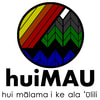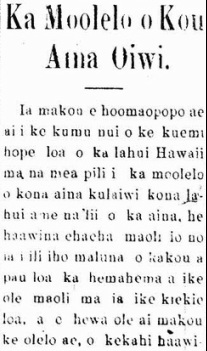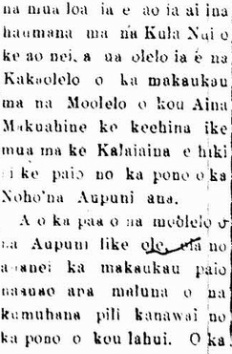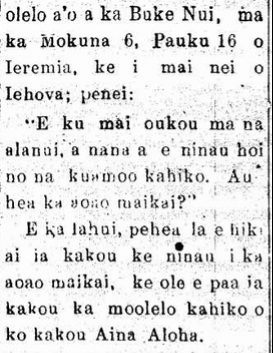Moʻolelo ʻĀina
moʻolelo: n. Story, tale, myth, history, tradition, literature, legend, journal, log, fable, essay, chronicle, record, article. ʻāina: An eating; the means of eating; Land generally; a farm; a field; a country; an island.
|
Before the sugar plantations, before the cattle ranches, before the eucalyptus groves, there was (and still is) Hāmākua, an ʻāina rich is history and tradition.
Learn more about the moʻolelo of our ʻāina by clicking on Hāmākua in the map to the right! Featured Moʻolelo ʻĀinaFind moʻolelo, mele, ʻōlelo noʻeau, and photos from each of the ʻāina listed below by clicking on the links or by following the maps.
|
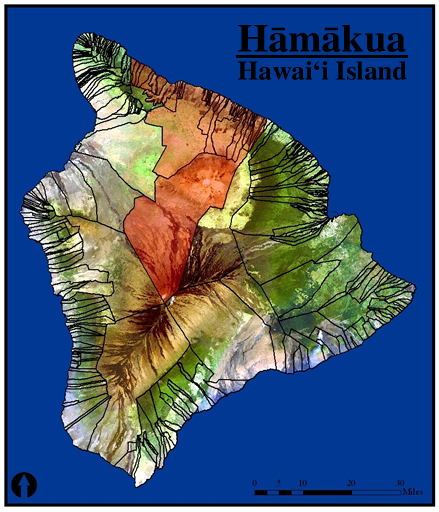
Hawaiʻi Island Ahupuaʻa Map. By N. Peralto. (c) 2012.
|
Ka Moʻolelo o Kou ʻĀina ʻŌiwi: The Moʻolelo of Your Native Homelands
Why our kūpuna thought it was important to know the moʻolelo of our ʻāina, and why we must continue to pass on these moʻolelo today!
The following is an excerpt from an article written in Ka Nai Aupuni on January 17, 1906 by Joseph Mokuohai Poepoe. As the editor of the newspaper, Poepoe was also one of the most prolific ʻŌiwi scholars and authors of the early 20th century. Read his thoughts about the importance of knowing the moʻolelo of your ʻāina ʻōiwi in the article below!
The following is an excerpt from an article written in Ka Nai Aupuni on January 17, 1906 by Joseph Mokuohai Poepoe. As the editor of the newspaper, Poepoe was also one of the most prolific ʻŌiwi scholars and authors of the early 20th century. Read his thoughts about the importance of knowing the moʻolelo of your ʻāina ʻōiwi in the article below!
|
Ka Moolelo o Kou Aina Oiwi
Ia makou e hoomaopopo ae ai i ke kumu nui o ke kuemi hope loa o ka lahui Hawaii ma na mea pili i ka moolelo o kona aina kulaiwi kona lahui a me na ‘lii o ka aina, he haawina ehaeha maoli io no ia i ili iho maluna o kakou a pau loa ka hemahema a ike ole maoli ma ia ike kiekie loa, a e hewa ole ai makou ke olelo ae, o kekahi haawina mua loa ia e ao ia ai i na haumana ma na Kula Nui o ke ao nei, a ua olelo ia e na Kakaolelo o ka makaukau ma na Moolelo o kou Aina Makuahine ke keehina ike mua ma ke Kalaiaina e hiki ai ke paio no ka pono o ka Noho’na Aupuni ana. A o ka paa o na moolelo o na Aupuni like ole, eia no auanei ka makaukau paio naauao ana maluna o na kumuhana pili kanawai no ka pono o kou lahui. O ka olelo ao a ka Buke Nui, ma ka Mokuna 6, Pauku o Ieremia, ke i mai nei o Iehova, penei: “E ku mai oukou ma na alanui, a nana a e ninau hoi no na kuamoo kahiko. Auhea ka aoao maikai?” E ka lahui, pehea la e hiki ai ia kakou ke ninau i ka aoao maikai, ke ole e paa ia kakou ka moolelo kahiko o ko kakou Aina Aloha? * Palapala ʻia e N. Peralto |
The Moʻolelo of Your Native Homelands
As we are looking to understand the reason for the decline of the Hawaiian nation in respect to [the knowledge of] the moʻolelo of their ʻāina kulāiwi, their nation, and the aliʻi of the ʻāina, it is truly a painful lesson that has been inherited by all of us, [that is] the incomplete and lack of knowing this kind of knowledge of great prominence. And, so that we are not incorrect in our words, this is another primary lesson that should be taught to the students in the universities of this time; it has been said by the orators of old, that the knowledge of the moʻolelo of your motherland is the primary position of knowledge upon which a firm political stance can be made so that [we] may fight for the pono of our governance. And being versed in the histories of other governments, that is what will prepare you to fight with a consciousness of the subjects related to the laws and edicts for the pono of your nation. The words of the bible, in chapter 6 of Jeremiah, Jehovah says this: “Stand, all of you, on the path, and look forth, and ask of the old pathways. Which is the good way?” Oh nation, how can we ask ourselves which is the good way, if we are not well-versed in the old moʻolelo of our ʻĀina Aloha? * Translated by N. Peralto |
